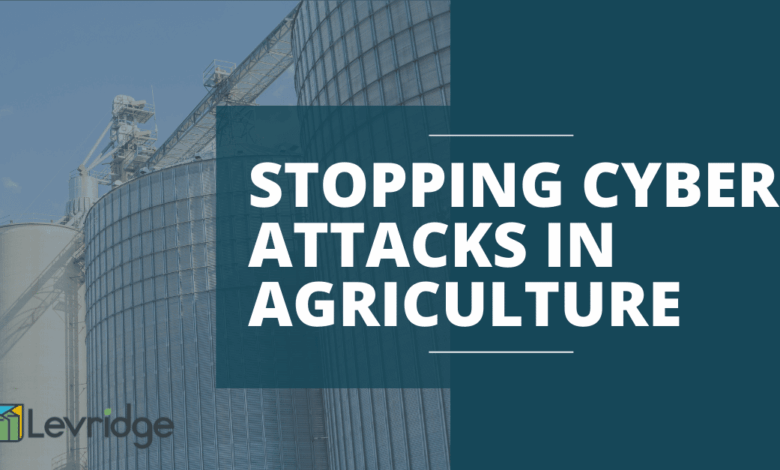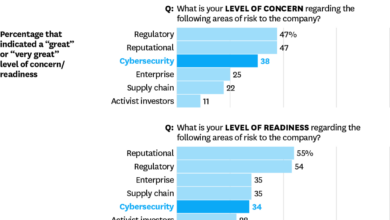
FBI Issues Ransomware Alert to US Agriculture
FBI Issues Ransomware Alert to the agriculture sector in the United States – that’s a headline that should make every farmer, rancher, and agricultural business owner sit up and take notice. We’re not talking about a minor inconvenience here; this is a serious threat to the very foundation of our food supply. This alert isn’t just a scare tactic; it’s a wake-up call highlighting the increasing vulnerability of the agricultural sector to sophisticated cyberattacks.
Ransomware isn’t just targeting big corporations anymore; it’s targeting the heartland, and the consequences could be devastating.
The FBI’s warning details specific ransomware threats targeting farms and agricultural businesses, outlining attack methods, potential impacts, and exploited vulnerabilities. The unique cybersecurity challenges faced by the agricultural sector – often reliant on older, less secure technology – are laid bare, emphasizing the urgent need for improved security practices. The alert also provides crucial recommendations and mitigation strategies, offering practical steps for bolstering defenses against these increasingly prevalent cyber threats.
FBI Alert Details

The recent FBI alert regarding ransomware attacks targeting the US agriculture sector highlights a serious and evolving threat. This isn’t just about data breaches; it’s about disrupting the nation’s food supply chain, impacting everything from planting and harvesting to processing and distribution. The alert underscores the need for heightened cybersecurity awareness and proactive measures within the agricultural industry.
Specific Ransomware Threat
While the FBI alert doesn’t name a specific ransomware variant in every instance, it emphasizes the increasing sophistication and frequency of attacks leveraging various strains. These attacks often involve exploiting known vulnerabilities in operational technology (OT) systems used to control agricultural machinery and infrastructure. The attacks are not limited to large-scale operations; smaller farms are also vulnerable. The common thread is the disruption of critical operations, leading to financial losses and potential food shortages.
Methods of Attack
The alert details several common attack vectors. Phishing emails remain a primary method, often containing malicious attachments or links that install ransomware. Exploiting vulnerabilities in outdated software, particularly in industrial control systems (ICS) and supervisory control and data acquisition (SCADA) systems, is another significant concern. Compromised remote access tools (RATs) are also frequently used to gain initial access to networks.
Finally, the FBI warns of the increasing use of supply chain attacks, where ransomware is introduced through seemingly legitimate software updates or third-party vendors.
Potential Impact on Agricultural Operations
The consequences of a successful ransomware attack on an agricultural operation can be devastating. Disruption to irrigation systems, planting and harvesting equipment, and livestock monitoring systems can lead to significant crop losses and livestock mortality. Data encryption can halt processing and distribution, causing spoilage and financial ruin. Furthermore, the downtime required for recovery and remediation can cripple operations for weeks or even months, severely impacting profitability and potentially leading to business closure.
The long-term impact on food security and the national economy should not be underestimated.
Examples of Exploited Vulnerabilities
The alert highlights vulnerabilities in older versions of common software used in agricultural settings, including SCADA systems, farm management software, and even simple accounting programs. Outdated firmware in agricultural machinery and equipment also presents a significant risk. For example, vulnerabilities in specific PLC (Programmable Logic Controller) models, widely used in automated irrigation systems, have been known to be exploited by attackers.
Lack of proper network segmentation also allows ransomware to spread rapidly throughout an agricultural operation’s network, causing widespread damage.
Farm Types Most Vulnerable
| Farm Type | Vulnerability Level | Reason | Mitigation Strategies |
|---|---|---|---|
| Large-scale farms with extensive automation | High | More complex IT infrastructure, greater reliance on interconnected systems, potentially larger attack surface. | Robust network segmentation, advanced threat detection, regular software updates. |
| Dairy farms | High | Dependence on milking systems, feed management, and environmental control systems. Disruption can cause immediate and significant losses. | Prioritize security for critical systems, implement backup and recovery plans, employee training. |
| Greenhouse operations | Medium-High | Environmental control systems are crucial. Ransomware could lead to significant crop loss. | Secure remote access, regular software patching, physical security measures. |
| Small farms with limited IT resources | Medium | May lack the resources for robust cybersecurity measures, making them vulnerable to phishing attacks and other simple methods. | Prioritize basic security practices, employee awareness training, utilize affordable security solutions. |
Agriculture Sector Vulnerability

The agriculture sector, a cornerstone of the US economy, faces a unique and growing threat: ransomware attacks. Unlike other industries, agriculture’s reliance on outdated technology, geographically dispersed operations, and a workforce often less technologically savvy creates a fertile ground for cybercriminals. This vulnerability isn’t just a theoretical risk; it’s a present danger with real-world consequences impacting food production and national security.
Unique Cybersecurity Challenges in Agriculture
The agricultural sector faces a complex web of cybersecurity challenges. The sheer scale and geographic distribution of many agricultural operations make centralized security management difficult. Many farms are spread across vast distances, with equipment and data scattered across multiple locations, making consistent security implementation a significant hurdle. Furthermore, the sector’s reliance on a mix of legacy systems and newer technologies creates a patchwork of vulnerabilities, often lacking integrated security solutions.
The agricultural workforce, while skilled in farming practices, may lack the specialized cybersecurity training needed to identify and respond to threats effectively. This combination of factors creates an environment ripe for exploitation by malicious actors.
Older Technology and its Security Implications
Many agricultural businesses continue to rely on older technologies, such as outdated control systems for irrigation, animal husbandry, and processing equipment. These legacy systems often lack the robust security features found in modern counterparts, making them easy targets for ransomware attacks. Furthermore, support and security updates for these older systems may no longer be available, leaving them vulnerable to known exploits.
The lack of secure remote access capabilities for these systems also presents a significant risk, as unauthorized access can lead to manipulation of critical infrastructure and data breaches. For example, a ransomware attack could disrupt irrigation systems, leading to crop failure, or compromise livestock management systems, causing significant animal welfare concerns.
Common Security Practices Lacking in Agricultural Businesses
A significant gap exists between the cybersecurity practices of the agricultural sector and those of more technologically advanced industries. Many agricultural businesses lack basic security measures such as strong password policies, multi-factor authentication, regular software updates, and employee cybersecurity training. The absence of robust incident response plans further exacerbates the situation, leaving businesses unprepared to effectively manage and recover from ransomware attacks.
Furthermore, many lack adequate data backup and recovery mechanisms, making it difficult to restore operations after a successful attack. This lack of preparedness contributes significantly to the sector’s vulnerability.
Examples of Successful Ransomware Attacks Targeting Agriculture
While specific details of many attacks remain confidential due to the sensitive nature of the information, several high-profile incidents have highlighted the devastating impact of ransomware on the agricultural sector. One example involved a large-scale meat processing plant that experienced a significant disruption in operations following a ransomware attack, leading to production delays and financial losses. Another example involved a dairy farm whose milking system was compromised, causing significant losses in milk production and impacting the livelihoods of farmers and their employees.
These examples underscore the real and significant threat ransomware poses to the sector.
Best Practices for Improving Cybersecurity in Farms
Implementing robust cybersecurity measures is crucial for protecting agricultural businesses from ransomware attacks. A comprehensive approach is needed, encompassing multiple layers of security.
- Regular Software Updates: Keep all software, including operating systems, applications, and firmware on all devices updated with the latest security patches.
- Strong Password Policies: Enforce strong, unique passwords for all accounts and utilize password managers.
- Multi-Factor Authentication (MFA): Implement MFA for all accounts to add an extra layer of security.
- Network Segmentation: Isolate critical systems and data from less sensitive parts of the network.
- Regular Security Audits and Penetration Testing: Conduct regular security assessments to identify and address vulnerabilities.
- Employee Cybersecurity Training: Provide regular training to employees on cybersecurity best practices, including phishing awareness and safe internet usage.
- Data Backup and Recovery Plan: Establish a robust data backup and recovery plan that includes regular backups stored offline or in a secure cloud environment.
- Incident Response Plan: Develop a comprehensive incident response plan to address ransomware attacks and other security incidents.
- Invest in Cybersecurity Technology: Consider implementing advanced security solutions, such as intrusion detection systems and firewalls.
- Regular Security Awareness Training: Conduct frequent training sessions for all employees to keep them updated on emerging threats and best practices.
FBI Recommendations and Mitigation Strategies
The FBI’s recent ransomware alert to the US agriculture sector highlights the critical need for robust cybersecurity measures. Farmers and agricultural businesses, often operating with older technology and limited IT staff, are particularly vulnerable. The recommendations provided aim to bridge this gap and bolster defenses against increasingly sophisticated cyberattacks. Understanding and implementing these strategies is crucial for protecting sensitive data, maintaining operations, and avoiding crippling financial losses.
The FBI’s recommendations focus on a multi-layered approach to security, encompassing preventative measures, incident response planning, and employee training. This holistic strategy recognizes that ransomware attacks can originate from various vectors, demanding a comprehensive defense. The key lies in proactive security measures, coupled with a well-defined response plan to minimize damage in the event of an attack.
Specific FBI Recommendations and Their Implementation
The FBI’s recommendations generally center around strengthening network security, implementing robust data backup and recovery systems, and educating employees about cybersecurity best practices. Agricultural businesses should prioritize implementing multi-factor authentication (MFA) on all accounts, regularly patching software and operating systems, and employing strong, unique passwords. Furthermore, they should regularly back up critical data to offline storage, ensuring these backups are tested and readily accessible.
This offline storage is critical to preventing ransomware from encrypting backups as well. Implementing these recommendations requires a dedicated effort, but the consequences of inaction far outweigh the investment. For example, a dairy farm that fails to back up its milking records could face significant financial losses if a ransomware attack encrypts its data.
Ransomware Prevention Techniques in Agriculture
Several ransomware prevention techniques are applicable to the agriculture sector, each with its strengths and weaknesses. Network segmentation, for instance, limits the impact of a breach by isolating critical systems. This approach is particularly effective in larger agricultural operations with diverse infrastructure. However, smaller farms may find implementing complex network segmentation challenging. Regular security audits, involving vulnerability scans and penetration testing, are essential for identifying and addressing weaknesses.
The FBI’s ransomware alert to US agriculture is a serious wake-up call. These attacks often leverage vulnerabilities in cloud systems, highlighting the critical need for robust security measures. That’s why understanding solutions like bitglass and the rise of cloud security posture management is crucial for protecting sensitive data. Ultimately, proactive cloud security is vital to mitigating the risk of these devastating ransomware attacks targeting our food supply.
These audits provide a clear picture of the farm’s security posture, allowing for proactive mitigation. Finally, employee training programs are crucial. Regular phishing simulations and security awareness training help employees identify and avoid malicious emails and websites, a common entry point for ransomware attacks. The effectiveness of these techniques is directly proportional to their consistent application and integration into the farm’s overall operations.
Software and Hardware Solutions for Enhanced Security
Several software and hardware solutions can significantly enhance the security posture of agricultural businesses. Next-generation firewalls, capable of detecting and blocking advanced threats, provide a robust first line of defense. Endpoint Detection and Response (EDR) solutions monitor endpoints for malicious activity, enabling rapid identification and containment of threats. These solutions can alert administrators to suspicious behavior, allowing for swift intervention.
Furthermore, data loss prevention (DLP) tools prevent sensitive data from leaving the network unauthorized, mitigating the risk of data breaches. Hardware-wise, secure network appliances and dedicated backup servers offer enhanced security and reliability. Investing in these technologies can significantly reduce the likelihood and impact of a ransomware attack. For example, a grain elevator could use a dedicated, physically secured server for storing crucial inventory data, protected from network-based attacks.
Creating and Implementing a Cybersecurity Plan: A Step-by-Step Guide
Developing a comprehensive cybersecurity plan is crucial for protecting agricultural businesses. This plan should be tailored to the specific needs and resources of the farm, but it should generally include these steps:
- Risk Assessment: Identify and assess potential threats and vulnerabilities specific to the farm’s operations and infrastructure.
- Policy Development: Establish clear cybersecurity policies and procedures, covering password management, data handling, and incident response.
- Technology Implementation: Implement appropriate security technologies, such as firewalls, antivirus software, and intrusion detection systems.
- Employee Training: Provide regular security awareness training to all employees, focusing on phishing scams, malware, and safe internet practices.
- Incident Response Planning: Develop a detailed incident response plan outlining steps to take in case of a ransomware attack or other cybersecurity incident.
- Regular Monitoring and Updates: Continuously monitor the farm’s network and systems for suspicious activity, and regularly update software and security patches.
- Backup and Recovery: Implement a robust data backup and recovery strategy, ensuring backups are stored offline and regularly tested.
- Regular Review and Updates: Regularly review and update the cybersecurity plan to reflect changes in technology and threats.
Economic and Societal Impacts
A widespread ransomware attack crippling the US agriculture sector would trigger a cascade of devastating economic and societal consequences, far exceeding the immediate financial losses incurred by individual farms and businesses. The interconnected nature of the agricultural supply chain means that disruption at one point can quickly amplify into a national crisis.The economic ramifications would be profound and far-reaching.
We’re not just talking about lost profits for farmers; we’re talking about potential food shortages, inflated prices, and a significant blow to the overall US economy, impacting everyone from grocery store owners to food processing plants and restaurant chains.
Economic Consequences of a Widespread Ransomware Attack
A successful ransomware attack could shut down critical agricultural operations for extended periods. Imagine processing plants unable to function, leading to spoilage of perishable goods. Consider the disruption to transportation networks, preventing the timely delivery of produce to markets. The financial losses would be enormous, encompassing not only the direct costs of paying ransoms (if paid), but also the losses from spoiled crops, disrupted supply chains, and decreased productivity.
The ripple effect would be felt across multiple sectors, impacting related industries like transportation, food processing, and retail. Estimates of economic losses would depend on the scale and duration of the attack, but we could easily see billions of dollars in damage. For example, the 2017 NotPetya ransomware attack, while not solely targeting agriculture, caused billions of dollars in damages across various sectors, offering a glimpse into the potential scale of the problem.
Impact on Food Security and Supply Chains
The US agriculture sector is a complex web of interconnected systems. A ransomware attack targeting any part of this network – from seed production to food distribution – could disrupt the entire chain. This could lead to shortages of essential food products, particularly fresh produce and perishable goods, driving up prices and potentially causing food insecurity for vulnerable populations.
The impact on food security would be particularly severe in regions with limited access to food or those already facing food insecurity challenges. Furthermore, the disruption of international trade and exports would have global implications, affecting food availability worldwide.
Consequences for Farmers and Agricultural Workers
Farmers and agricultural workers would be directly impacted by a ransomware attack, facing potential job losses, income reductions, and significant financial hardship. Many farms operate on tight margins, and a prolonged shutdown could lead to bankruptcy. The mental health consequences for farmers, already facing significant stress and economic pressure, could be devastating. Moreover, the attack could lead to a decline in the overall agricultural workforce, as farmers may struggle to attract and retain workers in the wake of such an event.
Long-Term Effects of Similar Attacks on Other Industries
The long-term effects of ransomware attacks on other industries provide a cautionary tale. The NotPetya attack, for instance, resulted in long-term disruptions to businesses, significant financial losses, and lasting damage to reputations. The Maersk attack, another significant ransomware incident, crippled the shipping giant’s operations for weeks, causing widespread supply chain disruptions. These examples highlight the potential for long-term economic and reputational damage, underscoring the critical need for robust cybersecurity measures in the agriculture sector.
Visual Representation of the Economic Ripple Effect
Imagine a graph with concentric circles. The innermost circle represents the initial ransomware attack on a farm or processing plant. The next circle outwards represents the immediate impact on related businesses – transportation companies, suppliers, etc. The subsequent circles represent the wider economic impact on food retailers, consumers, and ultimately, the national economy. Each circle grows larger, demonstrating the expanding impact of the attack, highlighting the escalating costs of lost productivity, spoiled goods, increased prices, and decreased consumer confidence.
The graph would visually demonstrate how a localized attack can quickly escalate into a widespread economic crisis.
Government and Industry Response
The recent surge in ransomware attacks targeting the US agriculture sector necessitates a robust and collaborative response from government agencies, industry organizations, and farmers themselves. A multi-pronged approach, combining proactive cybersecurity measures with swift and effective incident response, is crucial to mitigating the devastating economic and societal consequences of these attacks. This requires a significant shift towards a more proactive and collaborative cybersecurity landscape.The government plays a vital role in bolstering the cybersecurity defenses of the agricultural sector.
This involves a combination of direct support and strategic guidance.
Government Assistance to the Agriculture Sector
Federal agencies like the Cybersecurity and Infrastructure Security Agency (CISA) and the FBI are actively involved in providing resources and expertise to farmers and agricultural businesses. CISA offers numerous free cybersecurity resources, including vulnerability assessments, security awareness training, and incident response guidance. The FBI, through its various field offices and cybercrime task forces, actively investigates ransomware attacks and works to disrupt criminal networks.
Furthermore, government funding programs can incentivize the adoption of improved cybersecurity practices through grants and subsidies for technology upgrades and training. These initiatives aim to bridge the cybersecurity skills gap and improve the overall resilience of the sector.
Industry Initiatives for Improved Cybersecurity
Industry organizations, such as the American Farm Bureau Federation and the National Farmers Union, are taking the lead in promoting cybersecurity best practices among their members. These organizations provide educational materials, workshops, and webinars focusing on topics such as password management, software patching, and data backup strategies. They also advocate for stronger cybersecurity regulations and policies at both the state and federal levels.
Several agricultural technology companies are also developing and implementing innovative cybersecurity solutions specifically tailored to the needs of the agricultural sector, such as enhanced data encryption and intrusion detection systems. These efforts reflect a growing recognition of the importance of proactive cybersecurity within the industry.
The FBI’s ransomware alert for US agriculture is seriously worrying; cybercriminals are clearly targeting vital sectors. This highlights how crucial data security is, especially considering recent reports of facebook asking bank account info and card transactions of users , which shows how easily personal financial information can be compromised. Ultimately, the FBI’s warning underscores the need for heightened cybersecurity awareness across all industries, not just farming.
Collaboration Between Government, Industry, and Farmers, Fbi issues ransomware alert to the agriculture sector in the united states
Effective cybersecurity requires a collaborative approach involving government agencies, industry organizations, and individual farmers. Government agencies provide resources and guidance, industry organizations disseminate best practices and advocate for policy changes, and farmers implement these practices on their farms. This three-way partnership is essential for building a strong, resilient cybersecurity ecosystem within the agricultural sector. Open communication channels and regular information sharing are key to successful collaboration.
Sharing threat intelligence and incident response strategies ensures a rapid and coordinated response to ransomware attacks.
Examples of Successful Public-Private Partnerships
Several successful public-private partnerships already exist in other sectors that could serve as models for the agriculture industry. For instance, the collaboration between CISA and various private sector companies in sharing threat intelligence has proven highly effective in mitigating cyber threats. Similar partnerships could be established within the agricultural sector, leveraging the expertise of both government agencies and private cybersecurity firms to develop tailored solutions and response mechanisms.
The focus should be on creating a collaborative environment where information is freely shared, and resources are effectively utilized.
Framework for a National Cybersecurity Strategy for Agriculture
A comprehensive national cybersecurity strategy for agriculture should encompass several key components:
A robust framework for information sharing and collaboration between government, industry, and farmers.
Increased funding for cybersecurity research and development, focusing on solutions specifically tailored to the agricultural sector.
Mandatory cybersecurity training and awareness programs for all agricultural workers.
Incentive programs to encourage the adoption of advanced cybersecurity technologies and practices.
Development of clear and concise cybersecurity guidelines and best practices for the agricultural sector.
Establishment of a national agricultural cybersecurity task force to coordinate response efforts and share threat intelligence.
Regular cybersecurity assessments and audits of critical agricultural infrastructure.
The FBI’s ransomware alert for US agriculture is seriously concerning; farmers need robust, secure systems now more than ever. This highlights the importance of modernizing operations, and that’s where exploring options like those discussed in this article on domino app dev the low code and pro code future becomes crucial. Investing in secure, efficient technology is no longer a luxury but a necessity to protect against these kinds of cyber threats facing our food supply.
Summary
The FBI’s ransomware alert serves as a stark reminder of the growing cyber threat facing the US agriculture sector. The potential economic and societal impacts of a widespread attack are immense, impacting not only farmers’ livelihoods but also our national food security. The need for proactive cybersecurity measures is no longer a suggestion; it’s a necessity. Collaboration between government, industry, and farmers is paramount in developing and implementing robust cybersecurity strategies to protect this vital sector.
Ignoring this alert could have far-reaching and devastating consequences for all of us.
Quick FAQs: Fbi Issues Ransomware Alert To The Agriculture Sector In The United States
What types of ransomware are targeting the agriculture sector?
The FBI alert doesn’t specify particular strains, but it highlights the use of sophisticated ransomware that exploits vulnerabilities in older technology commonly used in agriculture.
What should I do if my farm is attacked by ransomware?
Immediately disconnect from the internet to prevent further spread. Contact law enforcement (FBI’s Internet Crime Complaint Center) and a cybersecurity professional. Do not pay the ransom.
Are there government programs to help farms improve cybersecurity?
Several government agencies offer resources and support for cybersecurity improvements in the agricultural sector. Check with the USDA and the Cybersecurity and Infrastructure Security Agency (CISA) for more information.
How much does ransomware protection cost for a farm?
Costs vary widely depending on the size of the farm and the level of protection needed. It’s best to get quotes from several cybersecurity providers to find the best fit for your budget and needs.





